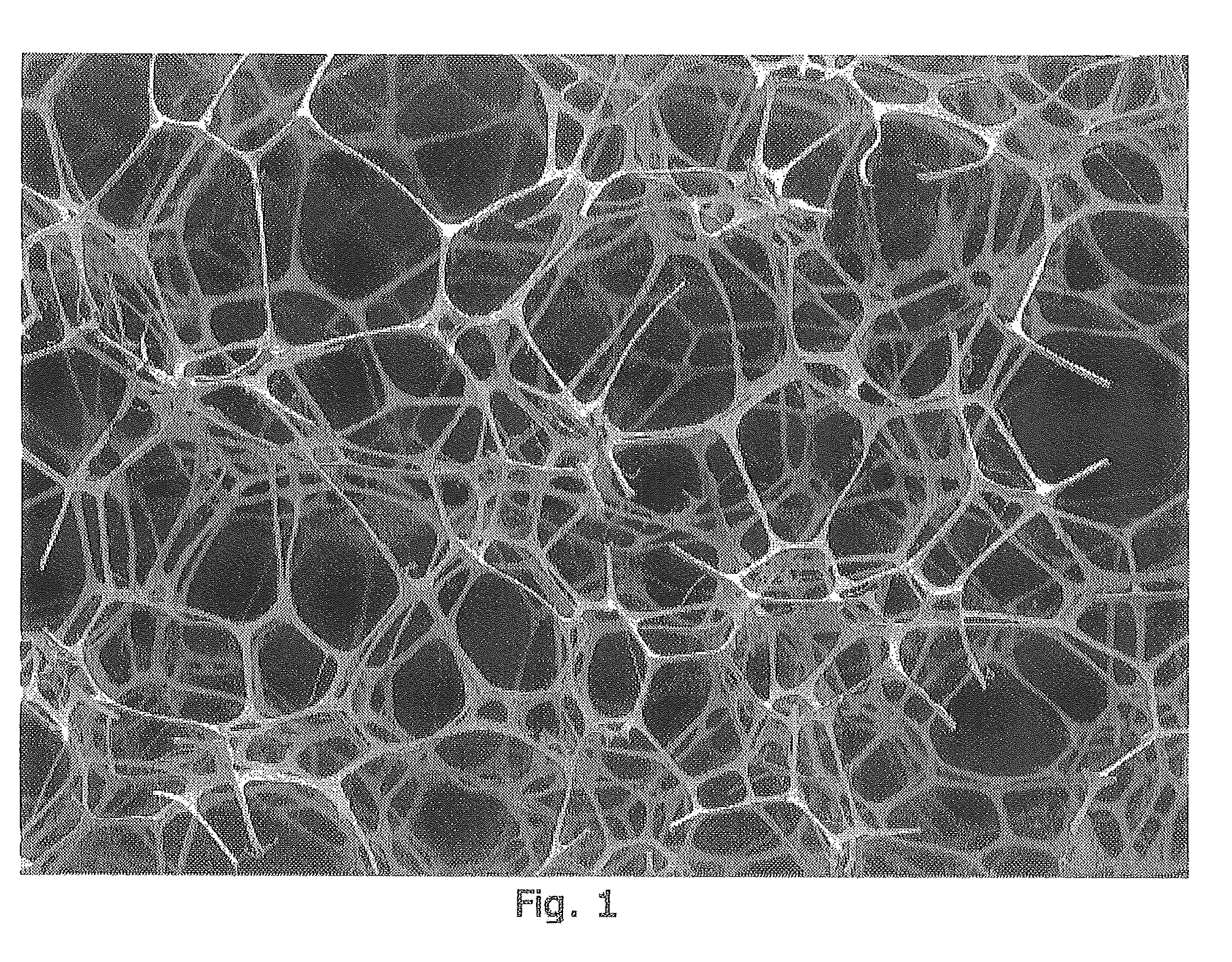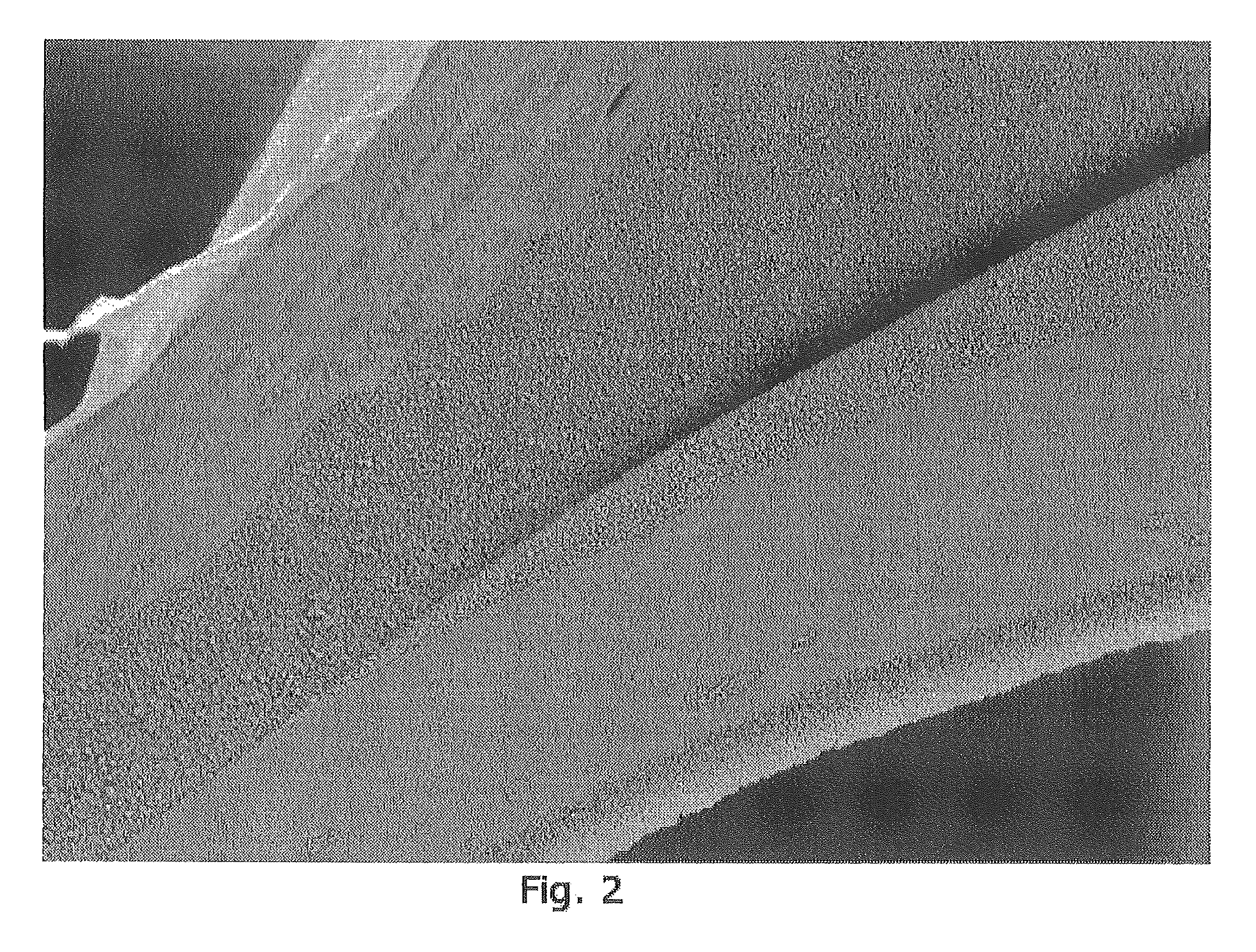Method for the production of abrasive foams
a technology of abrasive foam and production method, which is applied in the direction of manufacturing tools, applications, carpet cleaners, etc., can solve the problems of reduced rolling resistance in the rubber industry, increased elasticity of tires, and reduced rolling resistance of rigid foams, etc., and achieves marked abrasive properties and high elasticity. long-lasting
- Summary
- Abstract
- Description
- Claims
- Application Information
AI Technical Summary
Benefits of technology
Problems solved by technology
Method used
Image
Examples
example 1
Foaming of a Precondensate with Addition of Abrasive Nanoparticles
[0100]For production of a modified melamine resin foam in which the abrasive particles are incorporated into the foam simultaneously with the foaming process, 70 parts by weight of melamine-formaldehyde precondensate (with molar ratio 1:1.6) were dissolved in 30 parts by weight of an aqueous dispersion of colloidal silicon dioxide particles (solids content 45% by weight, average particle size 30 nm) before an emulsifier (3% by weight of an ethoxylated fatty alcohol having more than 20 ethylene oxide units), pentane (10% by weight), and formic acid (3% by weight) were added.
[0101]The mixture was then stirred and then foamed in a polypropylene (foaming) mold via irradiation with microwave energy at 2.54 GHz.
[0102]The product was heat-conditioned at a temperature of 220° C. for 30 minutes after the foaming process.
[0103]The foam structure of the foam, and its mechanical properties, its thermal stability, and its fire per...
example 2
Preparation of a Precondensate with Addition of Abrasive Nanoparticles
[0106]367.4 g (6.0 mol) of formaldehyde (49%) and 280.0 g of distilled water were used as initial charge in a 4 liter four-necked flask, and adjusted to pH 8.8 using 0.5 ml of sodium hydroxyide solution (NaOH, 25%). 30.8 g of an aqueous dispersion of colloidal silicon dioxide (solids content 40%, average particle size about 15 nm), followed by 472.5 g (3.75 mol) of melamine, were then added.
[0107]The mixture was heated to 98° C. and stirred at 98° C. and pH 8.8 (compensated) as far as the cloud point CP (1:5)=45° C. Once the cloud point had been reached, an icebath was used for cooling to room temperature. During cooling to room temperature, the pH rose to 9.5-10 as a consequence of temperature compensation.
example 3
Foaming of a Precondensate Comprising Nanoparticles
[0108]The precondensate obtained in example 2 was directly used for foaming and was foamed as follows:
[0109]10 parts by weight of the precondensate obtained in example 2 were added in 3% by weight of an emulsifier composed of an ethoxylated fatty alcohol (more than 20 ethylene oxide units), and also 3% by weight of formic acid, and 10% by weight of pentane, in each case based on resin.
[0110]The mixture was then stirred and then foamed in a polypropylene (foaming) mold via irradiation with microwave energy at 2.54 GHz.
[0111]The foam structure of the foam obtained, and its mechanical properties, its thermal stability, and its fire performance, do not differ significantly from those of a comparative foam produced without addition of the nanoparticles.
PUM
| Property | Measurement | Unit |
|---|---|---|
| boiling point | aaaaa | aaaaa |
| temperature | aaaaa | aaaaa |
| particle size | aaaaa | aaaaa |
Abstract
Description
Claims
Application Information
 Login to View More
Login to View More - R&D
- Intellectual Property
- Life Sciences
- Materials
- Tech Scout
- Unparalleled Data Quality
- Higher Quality Content
- 60% Fewer Hallucinations
Browse by: Latest US Patents, China's latest patents, Technical Efficacy Thesaurus, Application Domain, Technology Topic, Popular Technical Reports.
© 2025 PatSnap. All rights reserved.Legal|Privacy policy|Modern Slavery Act Transparency Statement|Sitemap|About US| Contact US: help@patsnap.com


